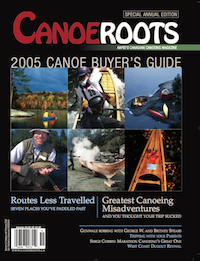For your next adventure, you don’t have to cook and eat like a second-year university student while on a backcountry canoe trip. What is it about travelling by canoe that makes otherwise-competent cooks regress into culinary basket cases? You don’t have to eat like a second-year university student out there. With the right preparation, equipment, recipes and, above all, attitude you can come to see trip meals as not just fuel for your body, but food for your soul.
PREP YOUR FOOD AT HOME
Measuring and bagging portions (rice, flour, pasta etc.) on a per-meal basis will save you time on trip. Don’t peel or chop vegetables or fruit beforehand, but cheese, cured meats and smoked salmon can be sliced and vacuum packed beforehand. Any vacuum packer worth its salt is expensive. Instead of buying your own, find a local deli that will vacuum pack things for you, including their drained olives or other deli-bar delicacies. If you buy enough and smile, you might even convince them to vacuum pack the sauce you’ve made for dinner on night four.
BUY A DEHYDRATOR
Once dehydrated, whole foods such as straw- berries, yams, onions, peppers, and puréed bananas become light, nearly spoil-proof and easy to pack. Prepared foods such as tomato sauce, potato-leek soup, or hummus also dehydrate well. Dehydrators cost around $50, come with helpful instructions and are simple to use. To rehydrate, just soak in hot water for 10 minutes.
LET THEM EAT CAKE
A cast-aluminum Dutch Oven costs about $60, a price tag that will seem very reasonable after just your first batch of brownies. Simply place burning embers on the lid and increase the heat by building twig fires on top of or around the oven. Dutch Ovens make the best breads, pizzas, muffins and cakes of any camping ovens. Recycle your reflector oven and save your Outback Oven for hiking trips.
EQUIP YOURSELF
You need the right tools to get any job done. Mucking around with potholders is the quickest way to spill sauces and burn food or yourself. Buy a pair of sturdy pliers and ignore the scratches they make on your stainless steel pot. Use a nonstick pan for sautéing and frying. They come in various sizes with
folding handles. Not only will you eat less carbon, you’ll spend less time scraping pots. Take insulated leather gloves. They perform miracles for your culinary dexterity and let you manipulate coals for the perfect baking and cooking fires.
REAL COOKS PACK A PANTRY
Take your favourite condiments. Why not have real maple syrup on day 28, butter on day six, cream in your coffee on day two, and ketchup in your mac and cheese? Buy egg replacer at the bulk store (powdered and inexpensive) so that you can make your cook- ies fluffy instead of flat. Bring a spice kit that includes salt, pepper, cayenne, hot sauce, gar- lic powder and whatever spices you reach for at home.
LUBRICATE YOUR PALATE
Forget about Gore-Tex and Kevlar, the great-est advance in outdoor outfitting has to be the 16-litre box of wine! When you’ve drained it, you can burn the box and inflate the bag for a pillow.
EAT FRESH DAIRY ON DAY 20
All you need to make yogurt is a good thermos that has been preheated with boiling water, yogurt culture, and milk powder. You can buy the culture packets from health food stores—just follow the instructions. Start it at night and eat it the next morning on por- ridge, granola or pancakes with those berries that you’ve rehydrated.
ROUGH RULES FOR ROUGHAGE
Food spoilage is hard to predict. I’ve eaten onions on day 32, red peppers on day seven and cream cheese on day five. I’ve also buried onions on day eight, burned pitas on day two and jettisoned red peppers before the put-in. To keep your fresh food from becoming compost, treat it like your meal depends on it. Pack perishables at the top of your packs. If you are paddling cold waters, make a ‘fridge barrel’ that contains your most sensitive items. This can be submerged each night and kept shaded all day. Each additional day you can keep it cool is cream in your coffee.
Mike and Beth got it cooking on 60-day Wanapitei trips.




